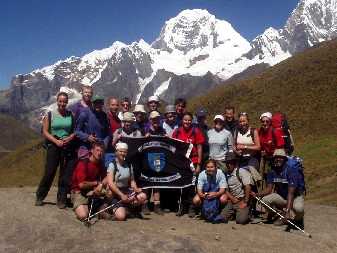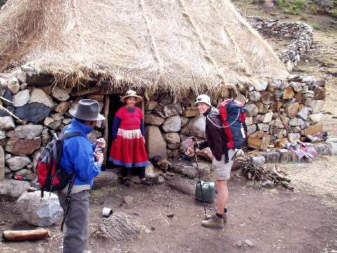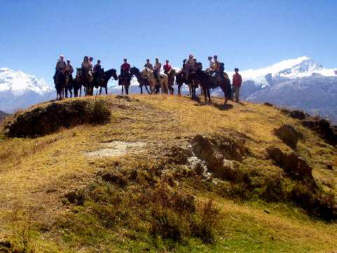Trekking Expedition ‘Northern Huayhuash’ - Peru, July 2003
Sheffield University Officers’ Training Corps
Huayhuash? …………….Why wash?
During my four years of study at the University of Sheffield, I haven’t really done the "Student Thing" of travelling to exotic places at the drop of a hat. So, when my OTC unit announced that they were organising a trip for 22 of us to go high altitude trekking in Peru, I jumped at the chance. Not only have I not travelled to many far-reaching and exotic locations, despite living on the doorstep of the Peaks for 4 years I have not done much hill walking either. The Huayhuash trip combined both of these perfectly and introduced me to a whole new world of outdoor activity (i.e. not dominated with running over hills holding a rifle).

|
The OTC has taught me a lot about "living in the field" and survival basics but only on the scale of 3-4 days at a time and at low altitude. The area we trekked in was part of the Cordillera Huayhuash and our hostel, when not camping in the mountains, was at already at 3000m: just walking from one bus to another on the first day was difficult! Fortunately, it got easier with time as our bodies started to acclimatise to the altitude. Our main trek was 8 days long and even though most of our kit was carried by a train of donkeys, it was still pretty hard going. I was able to utilise a lot of the skills I had learnt at OTC; things such as getting all my kit tided away before sunset (at 6pm) in my rucksack so I wouldn’t lose anything and certain tricks like waiting until I could bear it no longer before putting my Buffalo jacket on so I would appreciate the warmth for longer helped to make the trek a lot more comfortable. It may also have helped that Sabino (the chief ariero) was actually the "Del Boy" of the Andes. He knew exactly which lone huts sold soft drinks and beer, persuaded some locals to come and play traditional Peruvian music and sing for us, and also ensured everything was provided for us; by supplying 22 donkeys and 3 horses on which to carry our kit and all the food for the trek, a cook tent, multiple gas bottles, a twin gas stove and fresh meat in the form of 8 live chickens (whom we lovingly let out for walks and fed every evening). … which brings us to that old adage: it’s not what you know but who you know! We were fortunate enough to have our own coach or minibus to take us to the starting points of each of our treks. Wilson was our contact who ensured that the buses more or less arrived on time and not at the Latino equivalent. We realised how lucky we were to have him when he managed to convince the driver of another coach to reverse the best part of ½ km up an Andean mountain road to a suitable passing point so we wouldn’t have to do the same down a steep and not particularly secure road … In the dark. |
During my degree, I had the opportunity to study Spanish for four months. This gave me the initial benefit of being able to vaguely understand what was going on around me and so I was consequently landed with the position of unofficial group translator. This gave me numerous advantages. For example, during the main trek, when we were cooked for by the "arieros" (donkey wallopers), I was the first to know that breakfast or dinner was ready and so could strategically place myself in front of the cook tent before announcing it to the rest of the group. At the start of the trip, I knew enough Spanish to help me get around but by the end of the 2nd week, I was jabbering away with the locals and managing to get group price deals from taxi drivers, organise a day of horse riding and try to persuade traffic police that it wasn’t the third time our driver had been caught speeding in the space of an hour, honest.
All in all it was a fantastic trip which we all thoroughly enjoyed.
OCdt Michelle Minty

